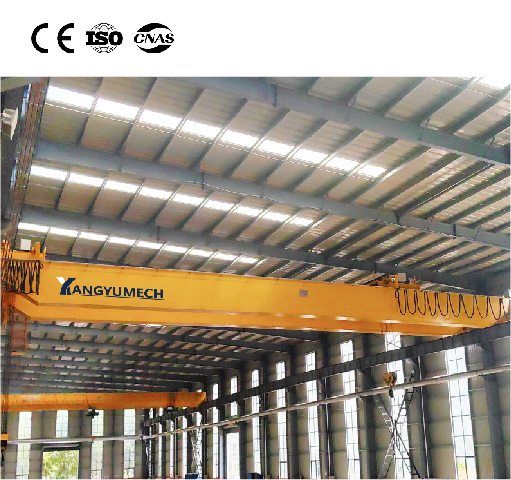Customizing a 5-ton overhead crane isn’t just about buying equipment—it’s about engineering a precision tool tailored to your facility’s workflow, spatial constraints, and operational demands. Yangyu cranes offer exceptional flexibility through modular design principles, but unlocking their full potential requires strategic planning. This guide breaks down the customization process using real industry data and technical benchmarks.

Critical parameters that dictate crane configuration:
Span & Headroom: For low-clearance facilities (<6m height), low-headroom hoists (e.g., European FEM designs) reduce hook-to-ceiling distance by 300–500mm vs. standard CD-type hoists .
Duty Cycle: M6 (medium-heavy) or A5 (heavy) work groups demand reinforced structures and premium motors.
Environmental Factors: In steel mills or foundries, specify H-class insulation for motors and corrosion-resistant coatings when ambient temperatures exceed 40°C or exposure to chemicals occurs .
*Comparative analysis of 5-ton crane options (based on 10.5m span benchmark)* :
| Crane Type | Price Range | Net Headroom | Lifting Height | Key Applications |
|---|---|---|---|---|
| Standard CD Hoist | $2,700 | 1120mm | 3135mm | Workshops, light assembly |
| Low Headroom | $3,100 | 802mm | 3645mm | Low-ceiling factories |
| European FEM/DIN | $6,000+ | 630mm | 3817mm | High-precision, heavy-cycle |
Structural innovations to request:
Lightweighting: Modern Yangyu designs reduce girder height by 9.7% and total weight by 16.3% (e.g., from 44,560kg to 37,276kg) using high-strength steel alloys .
Modular frames: 3-segment split designs (standard center section + adjustable end segments) enable rapid span adjustments via high-strength bolting .
Mandatory upgrades for specialized environments:
Dual braking systems: Essential for metallurgy. Primary brake + emergency safety brake activates if load exceeds 1.5x rated capacity or speed surpasses 125% .
Anti-sway & precision controls: ±6mm positioning accuracy via VFD drives (adds $6,000–$10,000) reduces load swing by 70% .
Redundant limit switches: Dual independent limiters (e.g., rotary + weight-type) prevent over-hoisting failures .
Industry 4.0 readiness enhancements:
Black box recorders: Logs stress cycles, overload events, and maintenance alerts (standard on FEM models) .
Regenerative power: Recaptures 15–25% of lowering energy via dynamic braking systems .
Remote diagnostics: PLC systems with fault-code displays enable rapid troubleshooting .
Modification matrix for harsh conditions:
| Environment | Critical Upgrades | Cost Impact |
|---|---|---|
| High Temperature | H-class motor insulation, glass-fiber thermal shields | +8–12% |
| Corrosive Atmospheres | Epoxy-coated wiring, stainless steel trolleys | +10–15% |
| Explosion Risk | ATEX-certified components, spark-resistant brakes | +20–30% |
Example: Foundries should add thermal barriers (e.g., rock wool under I-beams) to shield girders from radiant heat .
Non-negotiable safety systems:
Load moment indicators: Mandatory for冶金 applications, with visual/audible alarms at 90%/110% capacity .
Crane interlocks: Prevents conflicting movements (e.g., trolley travel while brake engaged) .
Emergency stop circuits: IP65-rated pendant controls with mushroom buttons.
Proven tactics to reduce TCO (Total Cost of Ownership):
Bulk orders: 5+ unit purchases secure 7–12% volume discounts .
Refurbished cores: Certified rebuilt hoists save 20–30% upfront with 80% residual lifespan .
Phased retrofits: Prioritize critical upgrades (e.g., VFDs) and defer cosmetic changes.
2025–2026 trend integrations:
AI collision avoidance: Upcoming Yangyu models will feature LiDAR-based object detection (+$8,000–$15,000) .
Predictive maintenance: Vibration sensors on gearboxes forecast bearing failures 3–6 months in advance.
Green certifications: ISO 14001-compliant models qualify for carbon tax rebates in 27 Chinese provinces .
*A Zhejiang plant customized 6 Yangyu 5-ton cranes with:*
19.5m spans (mid-range pricing at ¥55,000/unit)
Low-headroom hoists for 5.2m clearance workshops
IP54-rated wireless controls
Result: 22% faster production line transfers and 18% energy savings versus unmodified cranes .
Tailoring a Yangyu 5-ton crane demands methodical planning: start with spatial/operational diagnostics, select structural configurations balancing headroom and duty needs, then layer environment-specific protections and automation. Post-2025, prioritize modularity—Yangyu’s split-frame designs allow future span extensions or tech retrofits without full replacements. Always partner with suppliers offering lifecycle service packages; validated data shows they reduce 10-year TCO by 18–22% versus upfront cost savings alone.